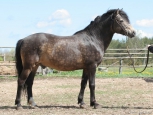Estonian Native Horse
Picture Gallery
History
There are different opinions about the origin of the Estonian native horse breed. Its establishment is as hypothetical as the one of Estonians. Anyway, Estonians and their horses have lived on this territory more than 5000 years.
The first written sources by the well-known traveller Adam von Bremen from the 11th century and the chronicles by Latvian Hendrik from the 13th century confirm, that Estonians were rich in gold and they had good horses. The breed has been appreciated by many nations and many stallions and mares were deported to Sweden as military horses and to Russian provinces to improve their local horse breeds.
Discussions have been held on the effect of knight horses (among these Arab Breed) on the Estonian Local Horse breed during the Middle Ages. It is obvious, however, that peasants succeeded to keep their horses apart from foreign “manor culture”.
On the 19th century a measures for development of the breed were put into practice: shows of the breeding horses, drawing and carriage competitions, awarding of the better horses and auctions. In the end of the century several studs were founded: 1856 in Tori on the mainland, 1870 in Uue-Lõve and 1902 in Uue-Mõisa on the island Saaremaa.
After the devastating influence of the World War I, the planned and purposeful pure-breeding of the Estonian Native Horse was started in 1921, when the Estonian Native Horse Breeders Society was founded. During 1921-1937 totally 13 stallions have been used in the breeding of the Estonian Native Horse. This has increased the wither height, white markings and chestnut colour of the breed that were mostly bay and without markings.
In the middle on the 19th century a strong horse was required in agriculture. For this purpose from Estonian Native Horse breed a universal Tori breed and Estonian heavy draught breed were developed by the 1920ies. The purebred Estonian Native Horse stayed on the islands and cost of the Western-Estonia thin soils. Such regional placement lasted until the beginning of 1980ies when the breed become a riding horse for children and tourism.
In 1992 re-founded Estonian Horse Breeders Society subsidizes the Estonian Native Horse foals with the help of government, society also organizes annual inspections and experimentations. In 2000 founded Estonian Native Horse Conservation Society, which unites the friends of the breed, organises group-events, exhibitions and bees, publishes books and newsletters.



